The EFL Championship has entered the play-off stage which will decide the last team to be promoted to the Premier League. Two of the teams qualified for this stage are Derby County and Leeds United. They met each other in the second play-off match which occurred on Saturday evening. And with the return leg just 24 hours away, get the latest customer sign up offers to back your bets – this analysis will give you plenty to consider.
Under the innovative and magnificent Marcelo Bielsa, Leeds have treated their fans with a high-tempo style of play. At times, the Yorkshire side were comfortable on top of the league table. But their inconsistent form cost them the season and they had to wait until the play-offs for their chance at promotion. Nonetheless, we should give credits to Bielsa himself because of his efforts to transform an ambitious squad into a promotion-contender.
In his first season as a manager, Frank Lampard has helped Derby secure a playoff spot by finishing 6th. His side boasts for their free-flowing attacking play, while still keep things tight at the back. This once again showed when Derby entered the match against Leeds at their home. They managed to keep Leeds quiet in the first half, but a second-half goal from Kemar Roofe gained Leeds a 1-0 advantage.
This tactical analysis will help you understand how Leeds overcame Derby’s pressure and won the first-leg. Meanwhile, using statistics, we will analyse what Lampard and his side need to do in the second leg.
Lineups
Lampard made one change when Derby welcomed Leeds. He switched the team’s formation from a 4-3-3 into a 4-2-3-1. Mason Mount and Bradley Johnson paired up as central midfielders while Duane Holmes played as an attacking midfielder. Alongside the United States-born midfielder was Liverpool loanee Harry Wilson and Tom Lawrence. Up front, veteran striker David Nugent became the focal point of Derby’s attacks.
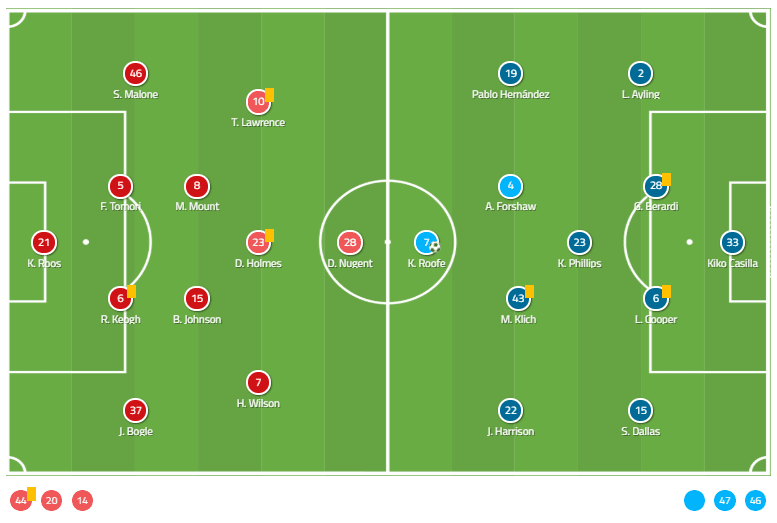
Bielsa also had one change to their usual 4-1-4-1. Swiss defender Gaetano Berardi came in for Pontus Jansson, who was a doubt with an ankle injury. Stuart Dallas continued to be the first-choice left-back as both Barry Douglas and Ezgjan Alioski were absented. Shielding in front of the defence was Kalvin Phillips, whose form was consistent throughout the season.
On the bench, Izzy Brown returned after an ACL injury. He was joined by goalkeeper Bailey Peacock-Farrell and other Leeds youngsters including Jack Clarke and Jamie Shackleton.
Derby’s style of play
There was a reason behind Lampard’s decision to line up in a 4-2-3-1 formation. The former Chelsea player wanted to dominate the middle area and win the midfield battle. He managed to accomplish that according to the graph below. Throughout the match, they won 38% of their challenges in the middle area and 2% lesser in Leeds’ third.
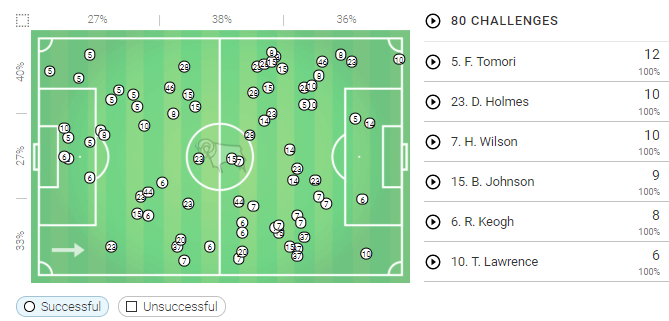
Usually, Derby pressed inside Leeds’ half to recover the ball and start a counter-attack. They would mark and follow a Leeds’ player until they reached their half. Players who have a high work rate and good positional awareness are required for this system. Their main responsibility would be to close down any spaces that Leeds’ players could capitalise. They should also be capable of sustaining the pressing structure, which was an important thing when playing against a fast-attacking side like Leeds.
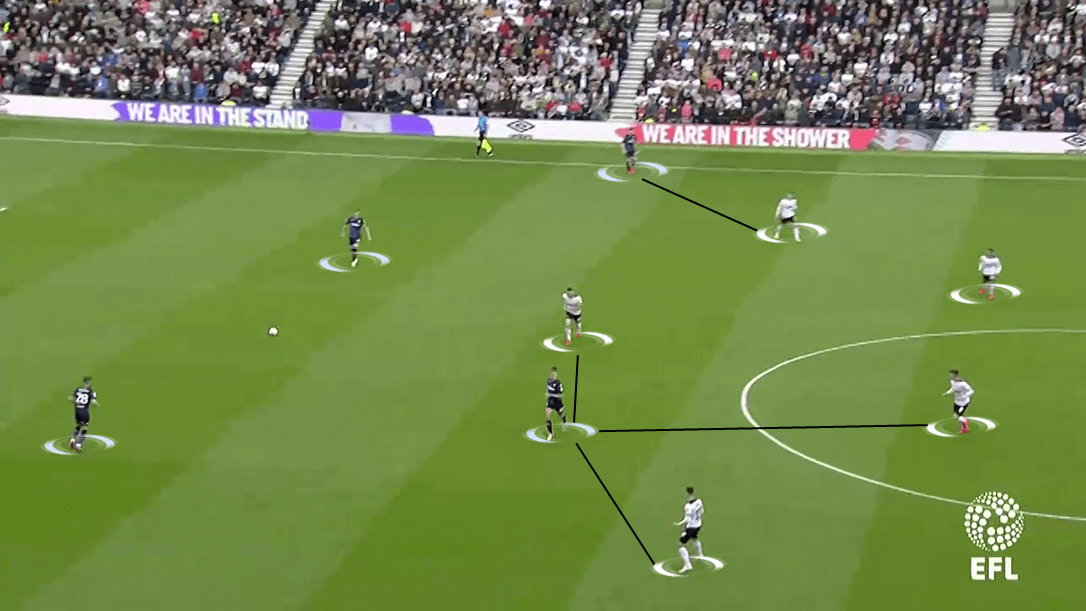
One of the main reasons that helped them in winning challenges was their compact defensive shape. Players usually congested to a certain area and attempted to overload that area. This forced Leeds to play back passes and restart their attack. In the meantime, they would stretch their shape out to continue marking the opposition’s players.
On some occasions, Leeds used long balls to switch the attacking direction. Derby dealt with this by shifting their shape across the field. Combining with their man-marking system, they aimed to keep Leeds’ players in control.
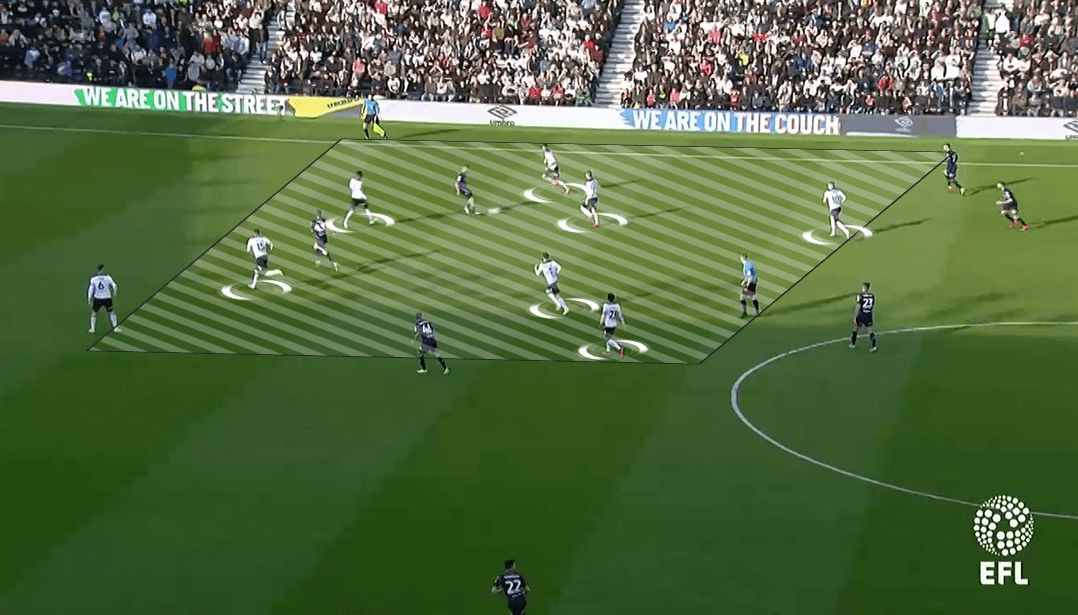
They also utilised their compact shape in pressing their opponent. The central midfielders would actively move towards the ball-carrier, suffocating his spaces and passing options at the same time. Meanwhile, the full-backs and wingers tucked in and provide support for their teammates. If needed, either Richard Keogh or Fikayo Tomori, the centre-back, would join the pressing shape and aggressively win the ball.
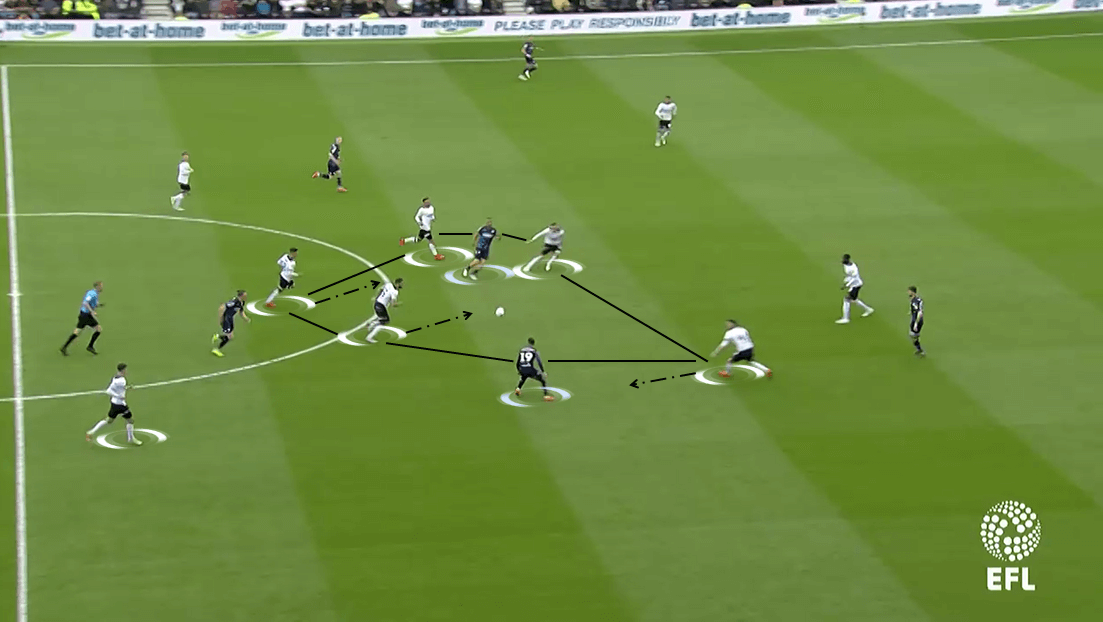
At times, Derby played with a 4-1-4-1 defensive structure. Mount would move out of his original position and play alongside Holmes. Along with the wingers, they formed the first defensive line. Between the lines was Johnson, whose responsibilities were to intercept through balls and provide shielding for the centre-backs.
They attempted to overload inside of their own half because they were aware of Leeds’ high-tempo style of play. This required the players to play with flexibility, ready to step out of the line and reach the ball. They also had to track players’ runs and intercept any passes coming towards other Leeds’ players.
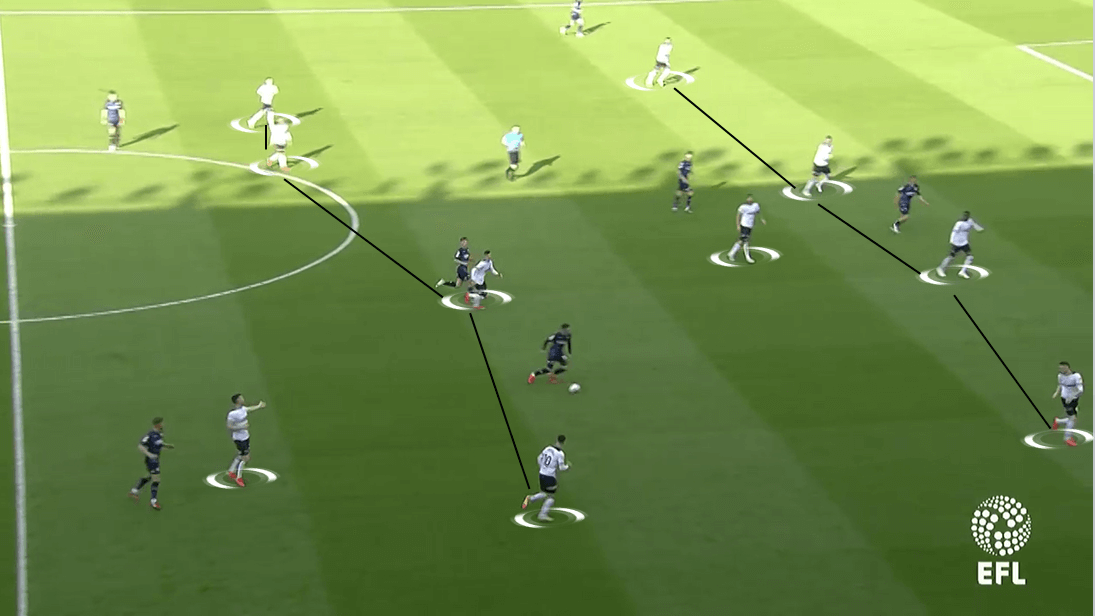
When in possession, Derby tended to play out from the back. Tomori and Keogh would stay close to each other and limit the risk from their passes. They also formed passing triangles at the same time, as demonstrated below. With five Derby players, they had created three passing triangles and Tomori had four passing options. Against a high pressing side, it is important to narrow the distance between players. It would allow Derby to distribute the ball more easily and fluently.
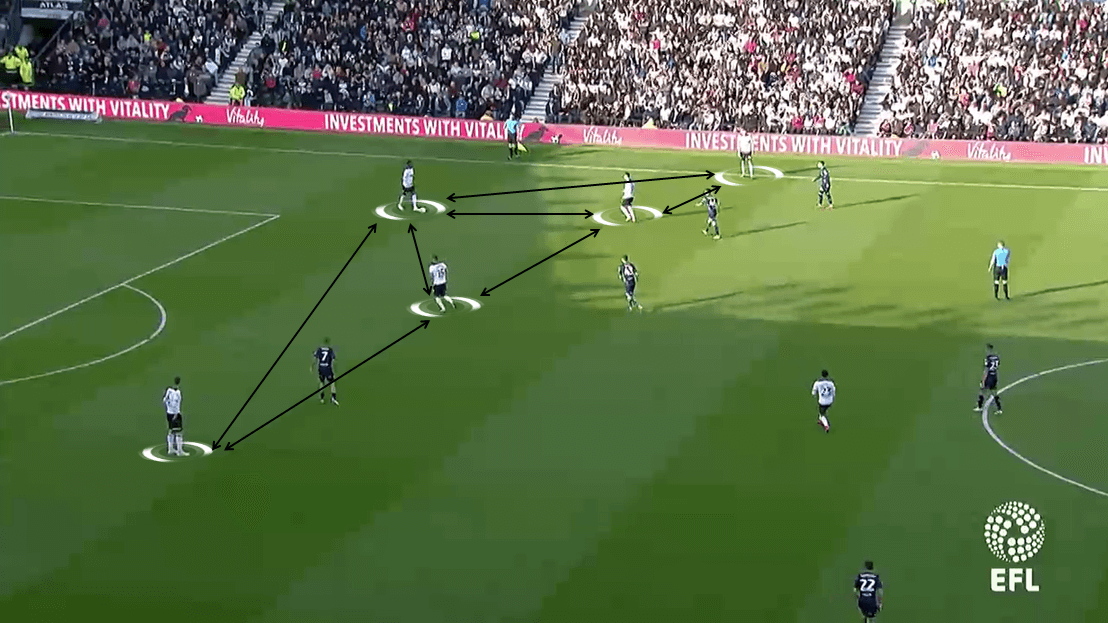
As good as they were on the ball, they couldn’t create many chances towards Leeds’ goal. In the first half, they didn’t own much of the possession. Only 26% during the mid-stage of the half, this showed how they were dominated by Leeds. But things got better for them in the second half. At times, they owned 64% of possession and their lowest was 53%.
On the other hand, though, they managed to create four chances in the first half compared to one in the remaining time. Still, all of them were all xG-rated below 0.1 and as a result, none of them were converted into goals.
Leeds’ style of play
One of Leeds’ distinctive styles of play that really caught the eyes of the pundits was their pressing. And they came into this match doing what they did best throughout the season. They pressed across the pitch and suffocated passing options that the Derby players had.
Combining with their man-oriented marking system, their press was even harder to deal with. It only took them a matter of a second to reach the ball-carrier while still keeping the Derby players around him in control. Thanks to their decision-making ability, they managed to accomplish this instruction comfortably.
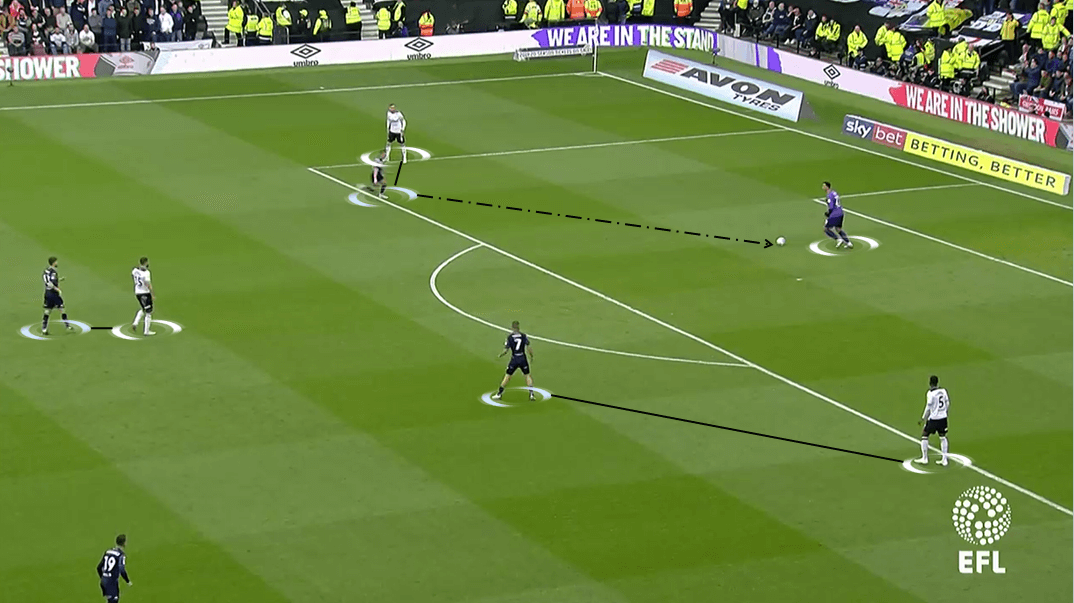
When the ball reached the middle third, two Leeds players would immediately step out and follow the ball-carrier. Bielsa wanted his players to disrupt Derby from building attacks while recovering possession high up the pitch. In the shot below, we can see Tomori being followed by Phillips and Hernández.
Those two eliminated every pass that could be played horizontally. At the same time, Mateusz Klich followed his closest passing option. This forced the Chelsea loanee to play long balls and usually, they were cleared by Leeds’ centre-backs.
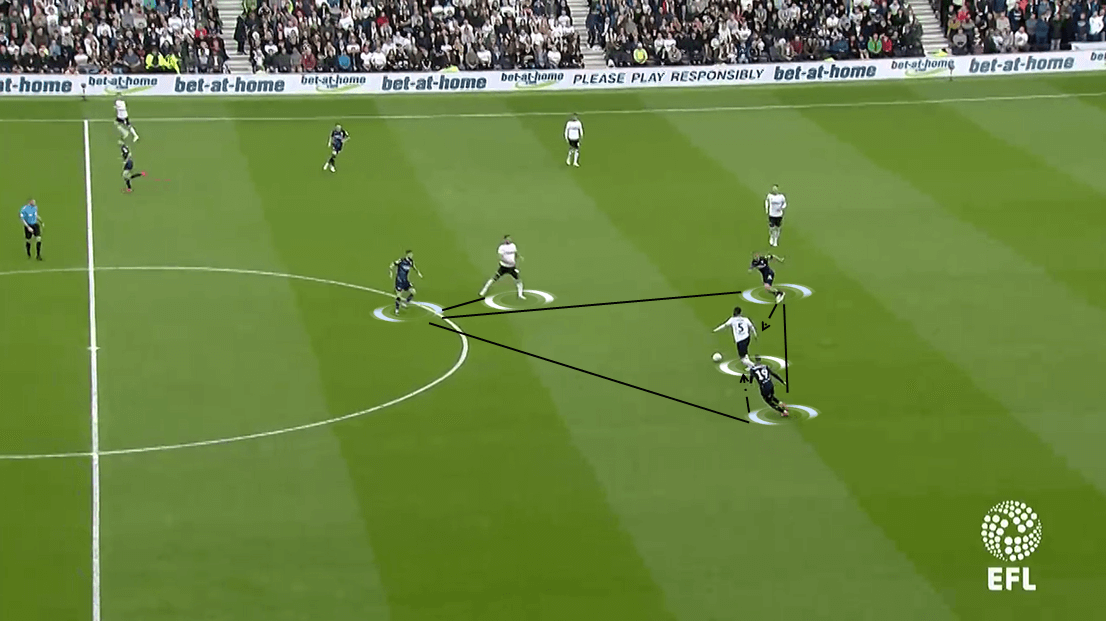
When in possession, Leeds tended to attack down the wings. Dallas and Luke Ayling are players that are capable of making dribbles up the pitch. They would overlap and occupy the wide spaces, while Hernández and Harrison occupied the half-spaces. Because of their wing-oriented style, it is easy to understand why they made many crosses. In total, 19 was the number of crosses that they made, and it doesn’t come as a surprise when knowing Ayling and Dallas was the top crossers for Leeds.
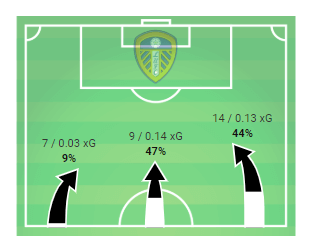
The only goal in this match, which came from Roofe at the 55th minute, came from a similar situation. From Dallas’ throw-in, Phillips picked up the ball and laid it back to him. Notice how the Northern Irish left-back made a one-two pass with Harrison and moved into the free space behind the Derby players.
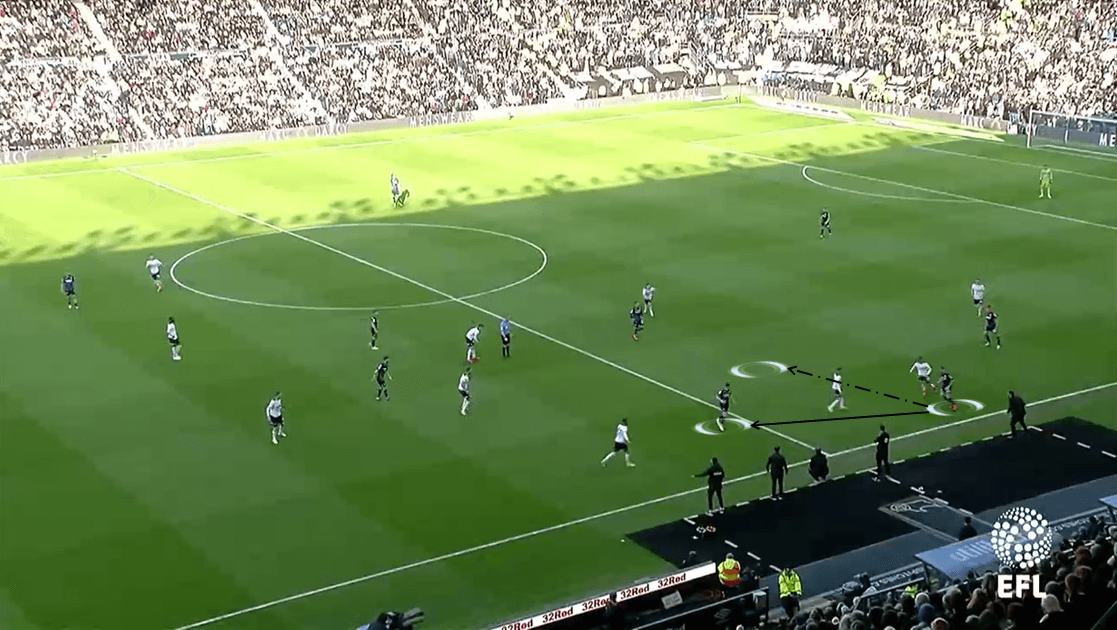
Later, Harrison picked up the ball and dribbled into the space that Jayden Bogle left behind. The Derby prospect didn’t have much time to recover from his error and couldn’t get to the ball. Meanwhile, Roofe managed to find himself behind Scott Malone, who didn’t even notice his run. The Manchester City loanee noticed that and made an early cross into the box. Roofe calmly converted and opened the score for Leeds.
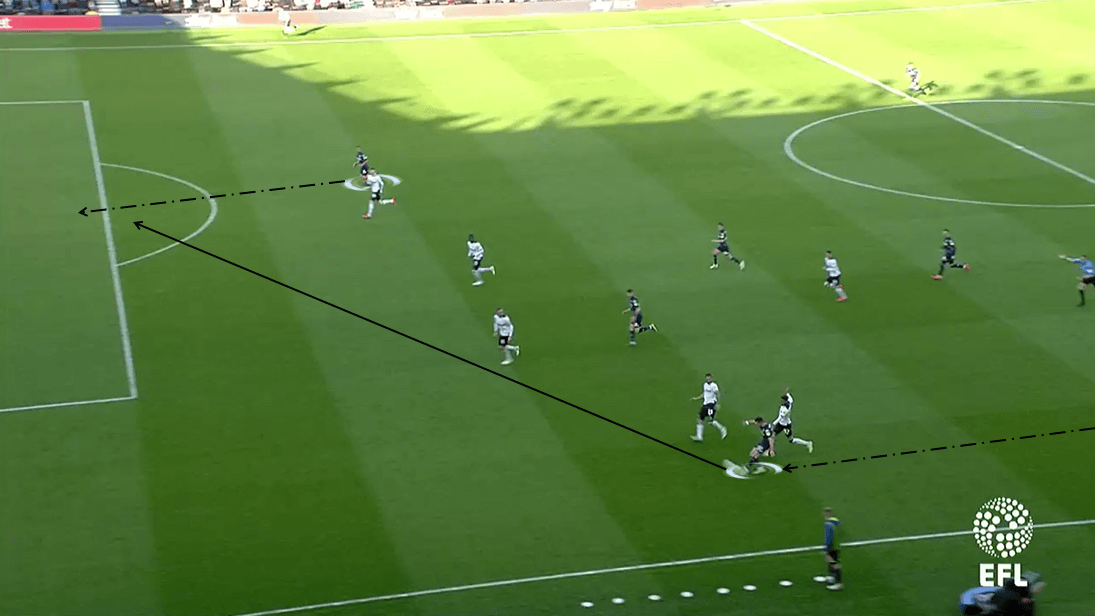
During the remaining time of the game, Leeds lowered their tempo in order to protect their lead. As seen on their possession graph, they only held an average of 44% of possession after Roofe’s goal. This allowed Derby to take control of the game and push forward. Still, they couldn’t find any ways into Kiko Casilla’s goal, thanks to the efforts of the defenders.
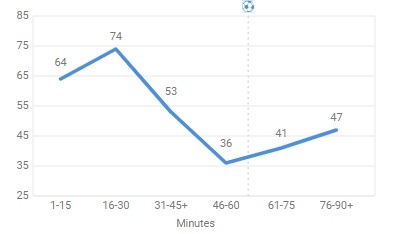
Conclusion
A thrilling and interesting first leg of the play-off came to an end with a narrow win for Leeds. Their free-flowing and high-tempo style of play helped them overcome Derby’s pressure and they came out on top thanks to Roofe’s goal. But a one-goal advantage won’t allow Bielsa to settle for now, as he turns his focus on the second leg this Wednesday.
For Lampard and his side, they still have hope of securing a play-off final spot at Wembley. What they did last Saturday was good, but not good enough to provide them with goals. Lampard may have regretted the decision of leaving Jack Marriott on the bench because he could have provided a decent threat and has the pace to beat Leeds’ defenders. Nonetheless, Derby had a great game and with some changes to the side, there is a chance that they could cause an upset at Elland Road.
If you love tactical analysis, then you’ll love the digital magazines from totalfootballanalysis.com – a guaranteed 100+ pages of pure tactical analysis covering topics from the Premier League, Serie A, La Liga, Bundesliga and many, many more. Buy your copy of the May issue for just ₤4.99 here, or even better sign up for a ₤50 annual membership (12 monthly issues plus the annual review) right here.





Comments